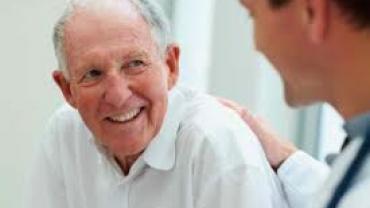
The word "osteoporosis" automatically brings to mind images of frail elderly women. Due to the decrease in estrogen,a facilitator of bone strength,in post-menopausal women older women are generally advised to engage in weight-bearing exercise and to consume a diet rich in bone-building nutrients such as calcium vitamin D magnesium and vitamin K2. All too often left out of discussions on bone health however is a population also at high risk for osteoporosis: older men.
Bone loss associated with advanced age is certainly not unique to women. According to the National Osteoporosis Foundation two million men have osteoporosis and another twelve million may be at risk. By age 60-70 men lose bone density at about the same rate as women. The Endocrine Society recommends that men over age 70 be screened for bone mineral density and also recommends testing for men ages 50-69 if specific risk factors are present. According to a study that evaluated data from a number of sources including the large ongoing NHANES project the lifetime risk for bone fracture in men over age 60 is 25% with this increasing to 42% for men with diagnosed osteoporosis,certainly not small numbers. The economic toll of fractures associated with low bone mass in men is over $3 billion per year. And the financial figures don't take into account the potentially devastating physical and psychological effects of fractures on men including the loss of mobility and independence.
Because osteoporosis is typically considered a condition exclusive to women men often do not receive important medical screenings or treatments for it even after presenting to health care professionals with fractures. In a retrospective cohort study that looked at over 1100 men age 65 or over who had presented with a new bone fracture only 13 (1.1%) underwent subsequent bone mineral testing. Just 7.1% of the total study population and 16.0% of those with a hip or vertebral fracture (presumably more debilitating than for example a wrist fracture) received osteoporosis medication.
A small study surveyed 23 men (ages 53 to 86) to assess men's attitudes toward osteoporosis. Most of them had experienced bone fractures and 17 (74%) were already taking prescription medication for osteoporosis. Despite using the medication many of the men cited a lack of confidence in the drugs' efficacy. Some reported seeing a loss of bone mineral density as an inevitable part of aging and as beyond their control regardless of diet and exercise. Others reported anger at health care providers for not informing them of reduced bone mass as a potential side-effect of pharmaceutical drugs they were taking or as co-morbidities with other conditions they experienced. They also expressed frustration that the majority of patient literature on bone health is aimed at women. An especially interesting reason the men provided for not being more proactive about seeking treatment was a feeling of stigmatization from having what is often considered,even among medical professionals,to be a "woman's disease."
An additional analysis of the same study cohort suggested that men delay seeking more thorough treatment for fractures because they may have a sense of invulnerability and do not want to be classified as weak or have their masculinity called into question. Some men expressed disappointment that their doctors failed to follow up on potential signs of bone loss such as decreased height or medical interventions that may cause bone loss such as androgen deprivation therapy.
The common attitude of nonchalance toward bone health among men was reflected in a study that surveyed over 1500 men (mean age 79) regarding their knowledge about osteoporosis. Only 39% of the male-specific questions were answered correctly prompting the study authors to recommend that bone health promotion campaigns which are typically targeted toward women be expanded to reach a male audience. This may be especially important as the Baby Boomer generation advances in age and patient populations with bone mineral loss will include more women and men.
Recommendations for preventing osteoporosis in men and strengthening men's bone mass in general mirror those provided for women: adequate bone-building nutrients supplemental vitamins and minerals when necessary periodic testing of bone mineral density and lifestyle counseling. The main novelties surrounding educating and treating men regarding bone health seem to be more effective patient outreach and perhaps even more important removal of the gender stigma.